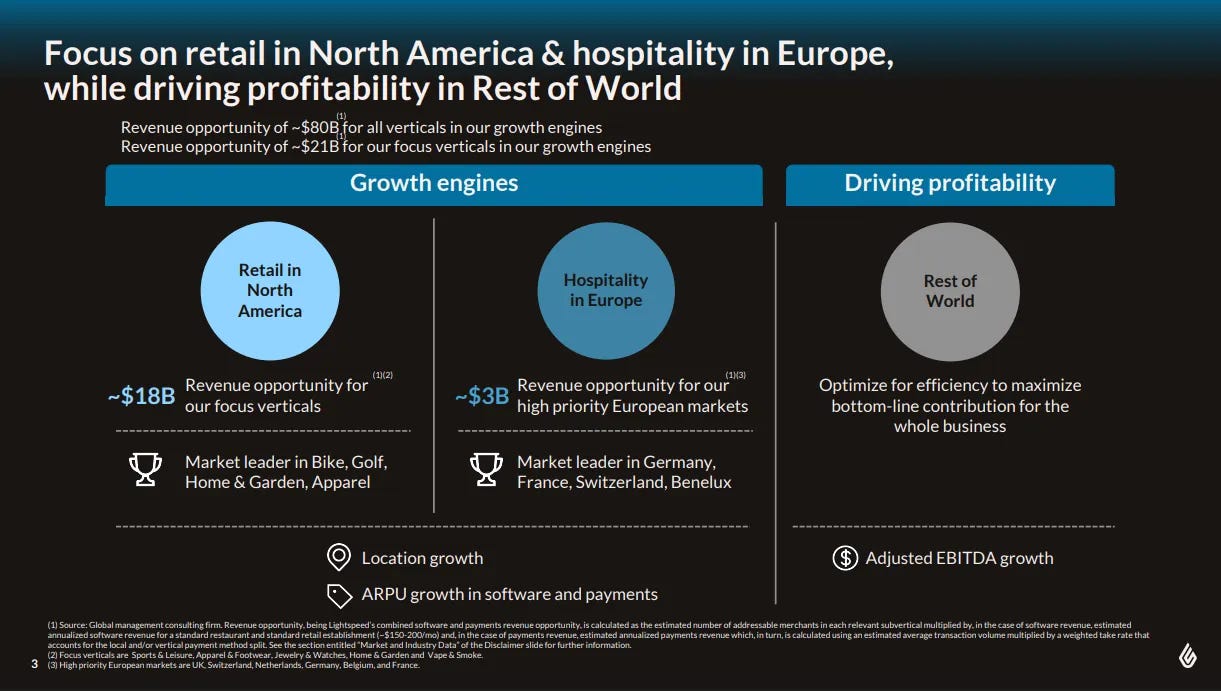🍕 Lightspeed - Capital Market Day's Learnings for Vertical SaaS Founders
Overlooked #197
Hi, it’s Alex from 20VC. I’m investing in seed & series A European vertical solutions (vSol) which are industry specific solutions aiming to become industry OS and combining dynamics from SaaS, marketplaces and fintechs. Overlooked is a weekly newsletter about venture capital and vSol. Today, I’m sharing learnings for SMBs-focused vertical SaaS founders from Lightspeed’s Capital Market Day.
Lightspeed is a marquee vertical software platform building an all-in-one operating system for small retail merchants and restaurants. It went public on the Toronto Stock Exchange in Mar. 2019. Its stock boomed during covid driven by the acceleration of cloud adoption in retail and hospitality as well as by an agressive M&A strategy. In 2022, the perception of the public market shifted when it realised that the roll-up strategy was detrimental and that Lightspeed was overspending in acquiring low-value merchants. Today, Lightspeed is in the middle of a massive restructuring with its original CEO & cofounder coming back at the helm of the company and massive measures being implemented.
The outcome of this restructuring has not yet been recognised by the market. The stock is at an all-time low. The company has a $1.2bn market cap. and a $550m enterprise value implying a 0.5x EV/LTM Sales multiple and a 1.3x EV/LTM Gross Profit multiple. We’re talking about a company doing $1.1bn in sales (growing 22% YoY), $438m in gross profit (growing 17.6%, 41.6% margin), $112m in operating losses (-10.5% of sales) with $661m in cash on the balance sheet.
As a comparison, there is a 10x different in EV/LTM Gross Profit multiple between Lightspeed and best-in-class vertical SaaS for restaurants Toast.
On Mar. 26th, Lightspeed organised a Capital Market Day to give an update on the restructuring. The company highlighted that growth will come from two core markets (EMEA for hospitality, US for retail) with three main goals: driving location growth, driving higher share of subscription and having great unit economics. For the rest of the business, Lightspeed will just focus on improving the profitability by milking the customer base and cutting costs.
In this post, I’ll focus mostly on the learnings for European SMBs vertical SaaS founders from studying what Lightspeed is doing with its EMEA hospitality business.
All SMBs are not equal
Following Toast’s playbook, Lightspeed is now exclusively focused on restaurants generating more than $500k in annual revenues. These customers are considered higher quality for several reasons:
Lower risk of churn due to bankruptcy,
More complex & restaurant specific software needs that cannot be met by a horizontal POS,
Higher ARPU potential across both software and transaction streams.
With this segmentation Lightspeed believes it is targeting a $3bn revenue opportunity across 6 countries: Belgium, the Netherlands, France, Germany, Switzerland and the UK.
Being revenue generator for your merchants.
Lightspeed is placing greater emphasis on helping its restaurant customers drive more revenue rather than focusing solely on improving their profitability. Delivering top-line growth is an easier sell to potential customers. With Lightspeed, restaurants can operate more efficiently, turning tables faster and increasing customer satisfaction - both of which contribute to higher revenue.
Cloud adoption is happening right now in Europe.
While vertical cloud solutions are approaching saturation among SMBs in the US with a 60% adoption rate, Europe remains largely untapped - with penetration rates of 20% in the UK, 8% in France and just 5% in Germany. In Europe, Lightspeed primarily competes against on-premise vertical SaaS for restaurants and basic cloud-based horizontal POS.
Winning in Europe requires deep localization — including country-specific integrations and full support for local regulatory requirements.
“Through deep local software integrations and country-specific fiscal integrations, we help restaurants tailor their system to their exact [local] needs.”
Field sales is a great go-to-market motion to serve small businesses.
Lightspeed deploys experienced field sales teams in cities with high restaurant densities. Currently, it has 55 field sales across 8 European cities and aims to scale to 100 across 19 cities by March 2026. At full scale, each city team consists of 1 field city manager, 6-10 field account executives and 2 implementation consultants.
“Our approach is hyper local. We're leveraging a city by city strategy with a strong feet on the street sales force to drive customer acquisition as well as expansion in key markets. By establishing a strong local presence in high-density urban areas, we ensure that we can establish direct relationships with restaurant owners and operators. This strategy ultimately allows us to provide a hands-on product demonstration, as you can experience later in the break. We can also go on site to ensure a smooth, rapid and onboarding process. And by being on site, being in those local markets, we also provide a localized support, all of which are critical in converting and retaining customers in the hospitality industry.”
Supporting restaurant brands with multiple locations.
Lightspeed supports multi-location workflows (e.g. aggregated reporting, multi-location menus & gift cards, shared customer data) enabling it to serve restaurant chains and scale alongside successful brands as they expand from a single location to multiple sites.
Doubling down on being an all-in-one platform.
Lightspeed started as a POS but has expanded its offering into an all-in-one platform for restaurants with a mobile tableside ordering system, a kitchen display system, and advanced analytics. This integrated approach allows Lightspeed to drive a higher SaaS ARPU and smoothly upsell its customer base by enabling additional modules to be activated directly through the platform, without requiring involvement from a salesperson.When Lightspeed sells the all-in-one software, it generates an average of $115 more per month in additional software fees compared to a POS-only sale.
Thanks to Julia for the feedback! 🦒 Thanks for reading! See you next week for another issue! 👋







